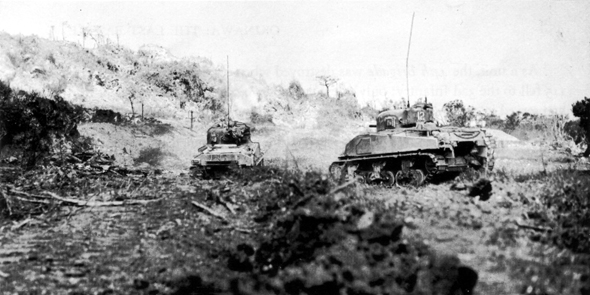On Okinawa, the insistent use of propaganda by means of leaflets and loudspeakers, by the American forces, induces some 343 Japanese troops to surrender.
Japanese forces fall back in some disorder along the frontage of the US 3rd Amphibious Corps but continue to resist along the line held by the US 24th Corps.

FIGHTING TOWARD HILL 89, tanks of the 769th Tank Battalion attack a bypassed Japanese strong point on top of Yaeju-Dake, 18 June 1945
On Okinawa, Japanese resistance along the center of the line, held by the US 24th Corps, continues to be strong.
The US 32nd Infantry Regiment (US 7th Division) reaches Height 89, near Mabuni, where the Japanese headquarters have been identified.
On the flanks, the American Marines on the right and the infantry on the left advance virtually unopposed, capturing over 1000 Japanese and reaching the southern coast of the island at several points.
The scale of surrenders is unprecedented for the forces of the Imperial Army.
Okinawa Background — Japanese Resistance Collapses
The Left and Right flank’s of the Japanese Kiyan line have collapsed. The USMC 3rd Corps put the 8th Marine Regiment of the 2nd Marine Division into the line (on the Japanese Left) fresh with A company 2nd Tank battalion and the 2nd Amtrac Battalion in support. The effect of fresh American troops on the punch drunk and under armed Japanese service troops was immediate and decisive. The 10th Army broke through on both flanks and naval gunfire had to be stopped for fear of hitting friendly troops.
This use of a fresh regiment towards the end of a campaign was a lesson learned for the USMC from Iwo Jima, when they saw the casualty figures from feeding in inexperienced replacements into units that had been in contact for too long.
The US Army had seen the same problem in Europe fighting the Germans and had reached a similar conclusion. The War Department had essentially recreated the World War One four infantry regiment division in it’s manpower plans for both Operations Olympic and Coronet.
After Okinawa 65
Now that the 65th anniversary of the Battle of Okinawa’s “Mop-up Phase” is about to start. I plan on doing a series of posts on Okinawa’s “School House of War” for US military planners and political leaders between now and the dropping of the first A-bomb.
I an going to touch on a number of subjects including the tactical lessons learned, planned American anti-Kamikaze countermeasures for the Kyushu landings, Japanese Military Leader’s plans to murder all Allied Prisoners of war and over run Allied civilians and the little touched on opposing chemical warfare postures of Japan and the Allies.
Looking forward to the next part of this series, Trent.
This is really appreciated. I have read Downfall but this detail is very much appreciated.
“On Okinawa, the insistent use of propaganda by means of leaflets and loudspeakers, by the American forces, induces some 343 Japanese troops to surrender….The scale of surrenders is unprecedented for the forces of the Imperial Army.”
There is less cause-and-effect here than you might think. Many of those who surrendered were Okinawa natives forcibly drafted into the Japanese Army; they were, understandably, less willing to sacrifice themselves for the glory of the Empire than were the regulars.